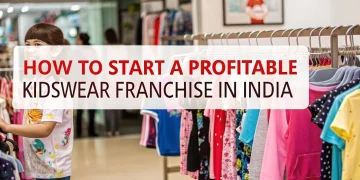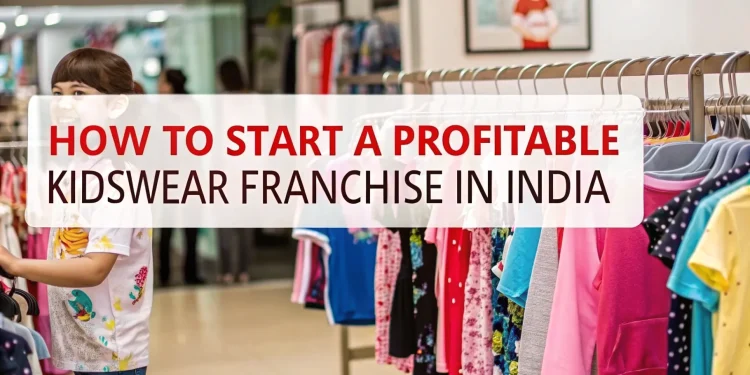The country’s expanding economy, growing disposable income for middle-class families and a growing awareness of fashion in the semi-urban and urban households have created a kidswear franchise market that is among the most promising segments in retail. With parents of all different income levels look for trendy, quality and authentic clothing that their child can wear, the market for kidswear is an attractive starting point for entrepreneurs who are looking to get started. For those who want to join the retail industry of fashion with minimal risk, establishing an apparel franchise for kids is an ideal blend of the value of a brand and scalable profits.
This guide will guide you through the process of understanding how to plan and launch a children’s clothing franchise in India and covers everything from potential industry opportunities and brand selection, to retail operations and the outlook for markets.
Understanding the Kidswear Franchise in India
The Indian children’s clothing segment has become a major sub-category within clothing industry. It is now a separate growing market that is caused by a number of key aspects. The demographics of India in which almost 30 percent of the population is younger than 14 is a huge source of customers for kids’ clothes. Furthermore, the impact from social networks, an increase in households with a double income and aspirational shopping fashions among parents in urban areas are driving demand for brand-name children’s clothing.
According to research conducted by market researchers that was conducted, according to market research, the Indian children’s clothing market is predicted to grow to Rs2 trillion by 2028, and is expected to grow by more than 8 percent. The most rapid growth is evident in cities of tier 2 and 3 where parents are swiftly moving away from local clothing that is not branded to retail stores. Trends in fashion for the season and themed school clothing, branded clothes and merchandising based on characters have been the main factors behind this increase.
Furthermore, the shift from buying on occasion to a year-round need for comfortable, stylish and safe clothes has resulted in a steady retail business. As the market gets more structured and franchise-driven growth models emerge, making it possible for national and regional brands to grow across the nation.
Related: How to Launch a Profitable Clothing Franchise in India
Why Kidswear Franchising Is a Smart Business Model
The process of opening a retail store independently requires a lot of branding inventory, marketing, and expenses, which could drain an business owner’s funds and time. Kidswear franchise remove the barriers to entry by providing a well-established brand, tested operating procedures, and constant support for marketing. For children’s clothing where brand trust and quality assurance are important for parents, franchising can help create trust immediately.
Franchisees also enjoy:
- Continuous supply chain support for the supply chain
- Seasonal product rotation, trends updates
- National branding and advertising campaigns
- Layout of the store and visual marketing
- Initial training and operation direction
An entrepreneur who does not have an extensive experience in fashion or retail can still manage a successful children’s clothing business with the help by the franchisor. Many well-known Indian brands such as FirstCry, Gini & Jony, Hopscotch, Little Kangaroos and many more offer flexible franchise models that are suited to different cities and investment capabilities.
Steps to Start a Kidswear Franchise in India
Prior to launching, it’s crucial to conduct thorough research and develop a strategy. Although many franchises offer support in the process of setting up stores as well as training previous work can help you succeed.
1. Research and Choose the Right Brand
Selecting the best Kidswear franchise brand could be the most important step. The factors to take into consideration are:
- Brand name recognition and reputation
- A range of products (infants, toddlers, teenagers)
- Manufacturing and quality of materials
- Support for Franchisors and Supply Terms
- Store formats (exclusive store outlets, multi-brand outlets kiosks in malls etc.)
Find out what kind of clientele the brand has. For example, if your store is situated in a prestigious mall, then a brand with a high-end price could be the best choice. In areas that have high footfall Mass-market brands that have a broad appeal may be more lucrative.
2. Select an Ideal Location
The location is the key to customers to your store and increases sales the retail. Your retail store should be located in:
- High-street retail areas with excellent visibility
- Shopping malls that are family-friendly or have a child-friendly design
- Residential clusters, near schools or playgrounds
Assess the location based on the demographics, presence of competitors parking, accessibility to parking, and the potential for walk-ins. A lot of franchisors help in the process of scouting locations and evaluating.
3. Legal Agreements and Documentation
After deciding on the brand, you must sign the franchise agreement which outlines the franchise fee revenue sharing, franchise fee models, contribution to marketing the exclusivity (territory rights) and exclusion clauses. Make sure you read every word carefully and consult with a lawyer.
It is also necessary to register your company (as sole proprietorship or partnership, or Pvt. Ltd.) as well as obtain an GST identification number and get local shop permits.
4. Set Up and Design the Store
The majority of franchises for kids have typical store designs that include display units, branding elements with billing counters, trial rooms. The layout blueprints are often provided and contact details for vendors for the interiors. A welcoming, vibrant and interactive layout improves the experience of customers and increases sales.
5. Hire and Train Staff
Find staff members who are friendly and able to manage adults (parents) and children with grace. Many brands provide product training as well as POS systems orientation. The initial few weeks of operations are essential for creating an enjoyable brand experience. A well-trained and friendly employees can make a difference.
6. Stocking and Inventory Management
The franchisee generally provides inventory based on forecasts of demand along with seasonal trend. Many of them use a consignment system (where un-sold inventory can be returned) and others opt for outright purchases. Keep optimal levels of stock keep track of items that move quickly and plan for seasonally-based clearance.
Related: Smart Textiles: The Intersection of Fashion and Technology
Digital Integration and Local Marketing
The Kidswear franchise company manages the national marketing, local exposure is equally important. Use:
- Geo-targeted ads on social media
- Local influencers, mommy bloggers or mommy influencers
- Events in-store (kids contests and workshops, giveaways)
- Partnerships with schools and tuition centers
Additionally, you can integrate your store into hyperlocal apps such as Dunzo, Swiggy Genie, or local delivery platforms. Offering WhatsApp ordering, or the option of video browsing to parents are a new trend. Some franchisees offer applications or tools online to help you connect the local store to their online presence across the country which can increase sales above the walk-in customer.
Challenges to Prepare For
While franchising reduces the risk of starting a business, there are still challenges. There is a lot of competition, both from other Kidswear franchise as well as online companies. The seasonal fluctuations in demand, particularly during school openings and holidays and holidays, can affect the flow of cash. Additionally, ensuring that customers are kept in a marketplace that parents are looking for diversity and value is a constant job.
To combat these, concentrate on establishing a local presence, ensuring consistent store experiences, and implementing rewards programs as well as referrals. Be aware of new products as well as seasonal trends and the preferences of customers is essential in ensuring long-term viability.
Watch the related article for more information
Future Outlook: Growth and Trends in Indian Kidswear
In the next stage of children’s clothing sales within India will be controlled by:
- Organic and sustainable clothing for toddlers and infants.
- Character merchandise (Disney, Marvel, etc.)
- Kids’ ethnic clothing during festivals
- Casual and smart for teens in the preteen years.
Franchise companies are already aligned to these developments. Expanding into rural and tier-3 markets, the introduction of AR-based try-ons using technology, and omnichannel sales will bring business growth. In 2030 India will be one of the leading three worldwide markets for children’s clothing in both value and volume.
Which business to start? How to choose a business idea?
Key Takeaways
Establishing a Kidswear franchise in India can be a profitable and long-lasting retail venture especially for new entrepreneurs. With a high level of trust in the brand as well as a growing demand and the support of franchisors this is an easy way to enter the rapidly growing clothing market. But, the key to success is carefully selected brands, careful strategic planning for location local marketing, and constant customer service.
If you’re trying to build an enterprise that is future-proof, with regular sales, seasonal highs and rising trends in spending A kidswear business is among the most profitable choices within the Indian retail market in the present.


















